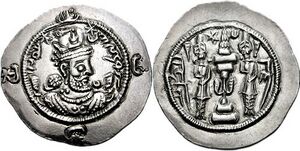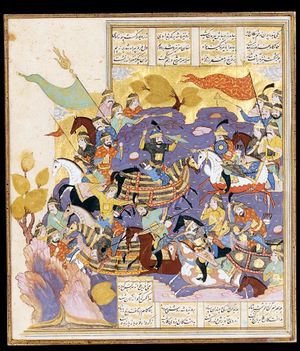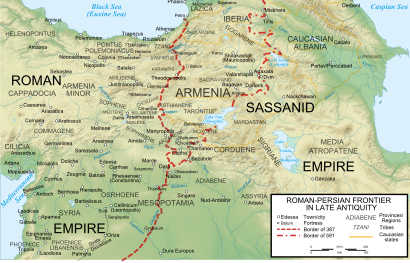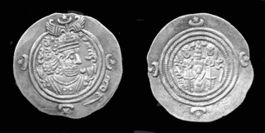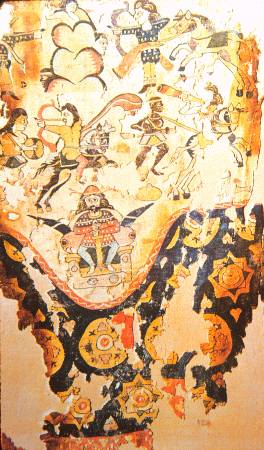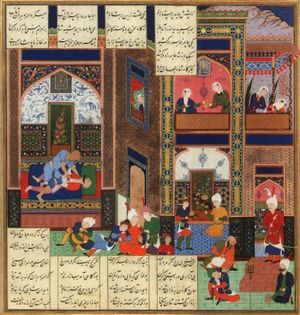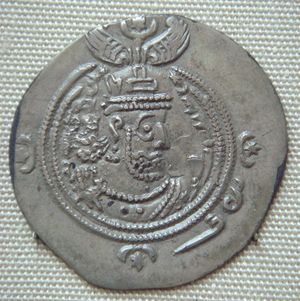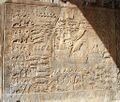كسرى الثاني
| Khosrow II 𐭧𐭥𐭮𐭫𐭥𐭣𐭩 | |
|---|---|
| King of Kings of Iran and non-Iran[أ] | |
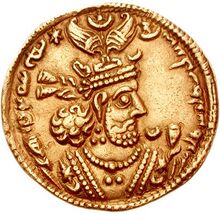 Gold dinar of Khosrow II, minted in 611 | |
| Shahanshah of the Sasanian Empire | |
| 1st reign | 590 |
| سبقه | Hormizd IV |
| تبعه | Bahram Chobin |
| 2nd reign | 591 – 25 February 628 |
| سبقه | Bahram Chobin |
| تبعه | Kavad II |
| وُلِد | ح. 570 |
| توفي | 28 فبراير 628 (aged around 57–58) Ctesiphon |
| Consort | |
| الأنجال | See below |
| البيت | House of Sasan |
| الأب | Hormizd IV |
| الأم | Unnamed Ispahbudhan noblewoman |
| الديانة | Zoroastrianism |
كسرى الثاني أو خُسرو الثاني (590 - 628) ، المعروف أيضاً بلقب برويز ومعناه ( المظفر ) ، كان ملك الدولة الساسانية في بلاد فارس . كان ابن هرمز الرابع، وحفيد كسرى الأول.
Khosrow II was the son of Hormizd IV (reigned 579–590), and the grandson of Khosrow I (reigned 531–579). He was the last king of Iran to have a lengthy reign before the Muslim conquest of Iran, which began five years after his execution. He lost his throne, then recovered it with the help of the Byzantine emperor Maurice, and, a decade later, went on to emulate the feats of the Achaemenids, conquering the rich Roman provinces of the Middle East; much of his reign was spent in wars with the Byzantine Empire and struggling against usurpers such as Bahram Chobin and Vistahm.
Khosrow II began a war against the Byzantines in 602, ostensibly to avenge the murder of his ally Maurice. Persian forces captured much of the Byzantine Empire's territories, earning Khosrow II the epithet "the Victorious". A siege of the Byzantine capital of Constantinople in 626 was unsuccessful, and Heraclius, now allied with Turks, started a risky but successful counterattack deep into Persia's heartland. Dissatisfied with the war, the feudal families of the empire supported a coup in which Khosrow II was deposed and killed by his estranged son Sheroe, who took power as Kavad II. This led to a civil war and interregnum in the empire and the reversal of all Sasanian gains in the war against the Byzantines.
In works of Persian literature such as the Ferdowsi's Shahnameh and Nizami Ganjavi's (1141–1209) Khosrow and Shirin, a famous tragic romance and a highly elaborated fictional version of Khosrow's life made him one of the greatest heroes of the culture, as much a lover as a king. Khosrow and Shirin tells the story of his love for the Armenian/Roman (originally Aramean) princess Shirin, who becomes his queen after a lengthy courtship strewn with mishaps and difficulties.
Name
"Khosrow" is the New Persian variant of his name used by scholars; his original name was Middle Persian, Husraw, itself derived from Avestan Haosrauuah ("he who has good fame").[1][2] The name is transliterated in Greek as Chosroes (Χοσρόης) and in Arabic as Kisra.[2] His name in combination with the epithet "Parviz" is attested in Georgian as K‛asre Ambarvez (Pseudo-Juansher, writing around the year 800) and in Armenian as Aprouēž Xosrov.[3][4]
Background
Khosrow II was born in ح. 570; he was the son of Hormizd IV and an unnamed noblewoman from the House of Ispahbudhan, one of the Seven Great Houses of Iran.[5] Her brothers, Vinduyih and Vistahm, were to have a profound influence in Khosrow II's early life.[5] Khosrow's paternal grandfather was the famed Sasanian shah Khosrow I Anushirvan (ح. 531–579), whilst his paternal grandmother was the daughter of the khagan of the Khazars.[6] Khosrow is first mentioned in the 580s, when he was at Partaw, the capital of Caucasian Albania. During his stay there, he served as the governor of the kingdom, and managed to put an end to the Kingdom of Iberia and make it into a Sasanian province.[5] Furthermore, Khosrow II also served as the governor of Arbela in Mesopotamia sometime before his accession to the throne.[7]
Rebellion of Bahram Chobin
Overthrow of Hormizd IV and accession
In 590, Hormizd IV had his prominent general Bahram Chobin disgraced and dismissed. Bahram, infuriated by Hormizd's actions, responded by rebelling, and due to his noble status and great military knowledge, was joined by his soldiers and many others. He then appointed a new governor for Khorasan, and afterwards set out for the Sasanian capital of Ctesiphon.[8] The legitimacy of the House of Sasan was based on acceptance that the halo of kingship, the xwarrah, was given to the first Sasanian shah, Ardashir I (ح. 224–242) and his family following the latter's conquest of the Parthian Empire.[9] This was now, however, disputed by Bahram Chobin, thus marking the first time in Sasanian history that a Parthian dynast challenged the legitimacy of the Sasanian family by rebelling.[9][10]
Meanwhile, Hormizd tried to come to terms with his brothers-in-law Vistahm and Vinduyih, who according to the Syriac writer Joshua the Stylite, both "equally hated Hormizd".[5][11] The two brothers overthrew Hormizd in a seemingly bloodless palace revolution.[5][11] They had Hormizd blinded with a red-hot needle, and put Khosrow II on the throne.[5][12] Sometime in the summer of 590, the two brothers then had Hormizd killed, with at least the implicit approval of Khosrow II.[5] Nevertheless, Bahram Chobin continued his march to Ctesiphon, now with the pretext of claiming to avenge Hormizd.[13]
Khosrow then took a carrot and stick attitude, and wrote a message to Bahram Chobin, stressing his rightful claim to the Sasanian kingship: "Khosrow, kings of kings, ruler over the ruling, lord of the peoples, prince of peace, salvation of men, among gods the good and eternally living man, among men the most esteemed god, the highly illustrious, the victor, the one who rises with the sun and who lends the night his eyesight, the one famed through his ancestors, the king who hates, the benefactor who engaged the Sasanians and saved the Iranians their kingship—to Bahram, the general of the Iranians, our friend.... We have also taken over the royal throne in a lawful manner and have upset no Iranian customs.... We have so firmly decided not to take off the diadem that we even expected to rule over other worlds, if this were possible.... If you wish your welfare, think about what is to be done."[14]
Fight
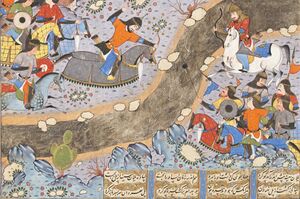
Bahram Chobin, however, ignored his warning—a few days later, he reached the Nahrawan Canal near Ctesiphon, where he fought Khosrow's men, who were heavily outnumbered, but managed to hold Bahram Chobin's men back in several clashes. However, Khosrow's men eventually began losing their morale, and were in the end defeated by Bahram Chobin's forces. Khosrow, together with his two uncles, his wives, and a retinue of 30 nobles, thereafter fled to Byzantine territory, while Ctesiphon fell to Bahram Chobin.[5] Bahram Chobin declared himself king of kings in the summer of 590, asserting that the first Sasanian king Ardashir I (ح. 224–242) had usurped the throne of the Arsacids, and that he now was restoring their rule.[8]
Bahram Chobin tried to support his cause with the Zoroastrian apocalyptic belief that by the end of Zoroaster's millennium, chaos and destructive wars with the Hephthalites/Huns and the Romans occurs and then a savior would appear. Indeed, the Sasanians had misidentified Zoroaster's era with that of the Seleucids (312 BC), which put Bahram Chobin's life almost at the end of Zoroaster's millennium, he was therefore hailed by many as the promised savior Kay Bahram Varjavand.[8] Bahram was to re-establish the Arsacid Empire and commenced a new millennium of dynastic rule. He started minting coins, where he is on the front imitated as an exalted figure, bearded and wearing a crenellation-shaped crown with two crescents of the moon, whilst the reverse shows the traditional fire altar flanked by two attendants.[8] Regardless, many nobles and priests still chose to side with the inexperienced and less dominant Khosrow II.[8]
In order to get the attention of the Byzantine emperor Maurice (r. 582–602), Khosrow II went to Syria, and sent a message to the Sasanian occupied city of Martyropolis to stop their resistance against the Byzantines, but with no avail.[15] He then sent a message to Maurice, and requested his help to regain the Sasanian throne, which the Byzantine emperor agreed with; in return, the Byzantines would re-gain sovereignty over the cities of Amida, Carrhae, Dara and Martyropolis. Furthermore, Iran was required to stop intervening in the affairs of Iberia and Armenia, effectively ceding control of Lazistan to the Byzantines.[5]
Return to Iran
In 591, Khosrow moved to Constantia and prepared to invade Bahram Chobin's territories in Mesopotamia, while Vistahm and Vinduyih were raising an army in Adurbadagan under the observation of the Byzantine commander John Mystacon, who was also raising an army in Armenia. After some time, Khosrow, along with the Byzantine commander of the south, Comentiolus, invaded Mesopotamia. During this invasion, Nisibis and Martyropolis quickly defected to them,[5] and Bahram Chobin's commander Zatsparham was defeated and killed.[16] One of Bahram Chobin's other commanders, Bryzacius, was captured in Mosil and had his nose and ears cut off, and was thereafter sent to Khosrow, where he was killed.[17][18] Khosrow II and the Byzantine general Narses then penetrated deeper into Bahram's territory, seizing Dara and then Mardin in February, where Khosrow was re-proclaimed king.[16] Shortly after this, Khosrow sent one of his Iranian supporters, Mahbodh, to capture Ctesiphon, which he managed to accomplish.[19]
At the same time a force of 8,000 Iranians under Vistahm and Vinduyih and 12,000 Armenians under Mushegh II Mamikonian invaded Adurbadagan.[8] Bahram Chobin tried to disrupt the force by writing a letter to Mushegh II, the letter said: "As for you Armenians who demonstrate an unseasonable loyalty, did not the house of Sasan destroy your land and sovereignty? Why otherwise did your fathers rebel and extricate themselves from their service, fighting up until today for your country?"[20] Bahram Chobin in his letter promised that the Armenians would become partners of the new Iranian empire ruled by a Parthian dynastic family if he accepted his proposal to betray Khosrow II.[21] Mushegh, however, rejected the offer.[21]
Bahram Chobin was then defeated at the Battle of Blarathon, forcing him to flee with 4,000 men eastwards. He marched towards Nishapur, where he defeated a pursuing army as well as an army led by a Karenid nobleman at Qumis. Constantly troubled, he crossed the Oxus river, where he was received honorably by the Khagan of the Turks, who was most likely Birmudha—the same Turkic prince that Bahram Chobin had defeated and captured a few years earlier during his wars against the Turks.[8][13] Bahram Chobin entered his service, and was appointed as a commander in the army, achieving further military accomplishments there.[8][22] Bahram Chobin became a highly popular figure after saving the Khagan from a conspiracy instigated by the latter's brother Byghu (conceivably an incorrect translation of yabghu).[13] Khosrow II, however, could not feel safe as long as Bahram Chobin lived, and succeeded in having him assassinated.[8] The assassination was reportedly achieved through distribution of presents and bribes between the members of the Turkic royal family, notably the queen.[22] What remained of Bahram Chobin's supporters went back to northern Iran and joined the rebellion of Vistahm (590/1–596 or 594/5–600).[23]
سيرته
وصل كسرى الثاني إلى العرش بمساعدة الأقطاب الذين ثاروا على هرمز الرابع حتى عام 590، مباشرة بعدما أعمي أبيه وقتل. وفي الوقت ذاته أعلن بهرام تشوبين نفسه ملكاً أيضاً تحت لقب الملك بهرام السادس، ولم يقدر كسرى على الإبقاء بنفسه.
حكم بعد كسرى الأول ابنه هرمز الرابع (579-589) ولكن قائده بهرام چوبين خلعه وأعلن نفسه وصياً على خسرو الثاني بن هرمز الرابع (589)، ثم أعلن نفسه ملكاً بعد عام واحد من ذلك الوقت. ولما بلغ كسرى سن الرشد طالب بعرش أبيه؛ فرفض بهرام طلبه، ففر كسرى إلى هيرابوليس في سوريا الرومانية؛ وعرض عليه الإمبراطور اليوناني موريس أن يعيده إلى ملكه إذا انسحب الفرس من أرمينية. ووافق كسرى على هذا الطلب؛ وشهدت طيسفون ذلك المنظر العجيب الفذ منظر جيش روماني يُجلس على العرش ملكاً فارسياً (596).
وبلغ كسرى أبرويز (الظافر) درجة من السلطان لم يبلغها ملك آخر من ملوك الفرس منذ أيام خشيارشا، ومهد السبيل لسقوط دولته؛ ذلك أنه لما قتل فوفاس موريس وجلس مكانه على العرش أعلن أبرويز الحرب على المغتصب (306) انتقاماً لصديقه؛ ولكن الواقع أن الحرب لم تكن إلا تجديداً للنزاع قديم. وكانت الدولة البيزنطية قد مزقها الشقاق والتحزب، فلم تجد جيوش الفرس صعوبة في الاستيلاء على دارا، وأميدا، والرها، وهيرابوليس، وحلب، وأباميا، ودمشق (605-613).
وزاد هذا النصر من حماسة أبرويز فأعلن الحرب الدينية على المسيحيين، وانضم 26.000 من اليهود إلى جيشه، ونهبت جيوشه المتحدة في عام 614 أورشليم، وقتلت 90.000 من المسيحيين(47)، وأحرقت كثيراً من كنائسها ومن بينها كنيسة الضريح المقدس، وأخذ الصليب الحق، وهو أعز أثر على المسيحيين، إلى بلاد الفرس. وأرسل أبرويز إلى هرقل Heraclius الإمبراطور الجديد رسالة دينية قال فيها:
| "من كسرى أعظم الآلهة وسيد الأرض كلها إلى هرقل عبده الغبي الذليل: إنك تقول إنك تعتمد على إلهك، فلم إذن لم ينقذ أورشليم من يدي؟" |
وفي 615، زحف خسرو الثاني پرڤيز، على رأس جيش جرار غازياً مصر. وبعد حصار طويل، استولى الفرس، في 616، على حاضرتها الإسكندرية بالخديعة واستولوا على ثروات هائلة. ثم هبت ريح عاتية أغرقت سفنهم المحملة بالغنائم من ثروات الكهنة والنبلاء. ولم يحل عام 619 حتى دخلت مصر كلها في حوزة ملك الملوك، وهو ما لم يحدث لها منذ أيام دارا الثاني. وفي هذه الأثناء كان جيش فارسي آخر يجتاح آسيا الصغرى ويستولي على خلقيدون (617)؛ ولبثت تلك المدينة في أيدي الفرس عشر سنين وهي التي لم يكن يفصلها عن القسطنطينية إلا مضيق البسفور. وكان أبرويز في هذه السنين العشر يدمر الكنائس، وينقل ما فيها من الآثار الفنية والكنوز إلى بلاد الفرس ويفرض على آسية الغربية من الضرائب الفادحة ما ينضب منه معينها وما أعجزها عن مقاومة غزو العرب الذي لم يكن بينها وبينه وقتئذ إلا نحو جيل من الزمان.
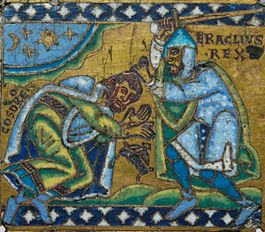
ثم ترك كسرى تصريف الحرب لقواده، وعاد لينقلب في اللهو والترف في قصره بدستجرد (على بعد نحو ستين ميلاً من طيسفون)؛ وقضى وقته بين الفن والحب. وجمع المهندسين، والمثالين، والمصورين، ليجعل عاصمته الجديدة أعظم شأناً من عاصمته القديمة، ولينحت صوراً مشابهة لشيرين أجمل زوجاته الثلاثة آلاف وأحبهن إلى قلبه. وشكا الفرس قائلين إنها امرأة مسيحية، وادعى بعضهم أنها قد أدخلت الملك في دينها، وسواء كان هذا أو لم يكن فقد سمح لها والحرب الدينية دائرة رحاها أن تنشئ كثيراً من الكنائس والأديرة. ولكن بلاد الفرس التي عمها الرخاء لكثرة ما أفاء عليها من الأسلاب والأرقاء، كان في وسعها أن تغفر لمليكها لهوه وترفه، وفنه، وتسامحه الديني، وترحب بفتوحه وترى فيها النصر النهائي على بلاد اليونان والرومان، ولأهورا مزدا على المسيح. لقد جوزي الإسكندر أخيراً على فعلته، وانتقم الفرس من اليونان لهزائمهم في مرثون، وسلاميس، وبلاتية، وأربيلا.
ولم يكن باقياً للإمبراطورية البيزنطية إلا عدد قليل من الثغور الأسيوية وقليل من أرض إيطاليا، وأفريقية، وبلاد اليونان، وأسطول لم يهزم بعد، وعاصمة محاصرة جن جنونها من الرعب واليأس. ولبث هرقل عشر سنين ينشئ جيشاً جديداً ودولة جديدة من أنقاض الجيش القديم والدولة القديمة. فلما تم له ذلك لم يحاول عبور البسفور إلى خلقيدون بل تجنب ذلك العمل الكثير النفقة والمشقة، وأبحر بأسطوله إلى البحر الأسود ثم اخترق أرمينية وهاجم بلاد الفرس من خلفها، ودمر كلورمية Clorumia مسقط رأس زرادشت، كما ضرب كسرى من قبل مدينة أورشليم، وأطفأ نارها المقدسة الخالدة (624). وسير إليه كسرى الجيوش يتلو بعضها بعضاً، ولكن هرقل هزمها جميعاً، ولما تقدم اليونان فر كسرى إلى طيسفون. وآلم قواده ما كان يوجهه إليهم من إهانات فانضموا إلى النبلاء وخلعوه، ثم سجنوه ولم يطعموه إلا الخبز القفار والماء، وذبحوا ثمانية عشر من أبنائه أمام عينيه، وانتهى أمره بأن قتله ابن من أبنائه يدعى شيروى (628).
Religious policy and beliefs
Khosrow II, like all other Sasanian rulers, was an adherent of Zoroastrianism.[24] Since the 5th-century, the Sasanian monarchs had been made aware of the significance of the religious minorities in the realm, and as a result tried to homogenize them into a structure of administration where according to legal principles, all would be treated straightforwardly as mard / zan ī šahr, i.e. "man/woman [citizen] of the country".[25] Jews and (notably) Christians had accepted the concept of Iran and considered themselves part of the nation.[25]
During his reign there was constant conflict between Monophysite and Nestorian Christians. Khosrow favored the Monophysites, and ordered all his subjects to adhere to Monophysitism, perhaps under the influence of Shirin and the royal physician Gabriel of Sinjar, who both supported this faith. Khosrow also dispensed money or gifts to Christian shrines.[26] Khosrow's great tolerance to Christianity and friendship with the Christian Byzantines even made some Armenian writers think that Khosrow was a Christian.[26] His positive policy toward Christians (which, however, was probably politically motivated) made him unpopular with the Zoroastrian priests, and also made Christianity greatly spread around the Sasanian Empire.[27] During Khosrow's war with the Byzantines, Christian elites and organizations were incorporated into the Sasanian system, as part of his attempt to absorb the Byzantine realm into his expanded empire.[28] The condition of the Christian nobility reached its pinnacle under Khosrow.[29] Mushegh II Mamikonian, a prominent Armenian nakharar, is the first and only Christian nobleman that is praised by courtly historiographers, due to his rejection of the enticements of Bahram Chobin. His decision to choose Khosrow over his native Armenia, gained him a place in the Shahnameh, the national epic of Iran.[29] Smbat IV Bagratuni likewise led an illustrious career under Khosrow, rising to the office of frontier commander of Gorgan, possibly the most vital and contested area of the Sasanian realm. As a reward for his accomplishments in the east, Smbat was appointed the leader of the military jurisdiction in the Caucasus. Furthermore, his aristocratic house–the Bagratunids–was made the pillar of Sasanian authority in the area.[29]
Khosrow also paid attention to the Zoroastrians, and had various fire temples constructed. However, this did not help the Zoroastrian church, which was in a heavy decline during his reign. According to Richard N. Frye, the Zoroastrian church under Khosrow "was noted for its devotion to luxury more than its devotion to thought."[30]
كسرى الثاني والنبي محمد عليه الصلاة والسلام
بسم الله الرحمن الرحيم
من محمد رسول الله الى كسرى عظيم الفارس . سلام على من اتبع الهدى و آمن بالله و رسوله و شهد ان لااله الا الله وحده لاشريك له و ان محمد عبده و رسوله. ادعوك بدعاء الله، فانى رسول الله الى الناس كافة لانذر من كان حيا و يحق القول على الكافرين. فاسلم تسلم . فان ابيت فان اثم المجوس عليك .
كسرى الثاني هو ملك الفرس الذي مزق الكتاب الذي بعثه النبي عليه الصلاة والسلام إليه ليدعوه وقومه إلى الإسلام ، وقد قال النبي عليه الصلاة والسلام بعد تمزيق كسرى لكتابه : ( مزق الله ملكه ) .
Music during the reign of Khosrow II
Khosrow II's reign was considered a golden age in music. Before Khosrow II there were many other Sasanian kings that showed particular interest in music, like Khosrow I, Bahram Gur, and even Ardashir I. Notable musicians during the reign of Khosrow II were Barbad (Khosrow's favorite court musician), Bamshad, Sarkash, and Nagisa.
Rock reliefs
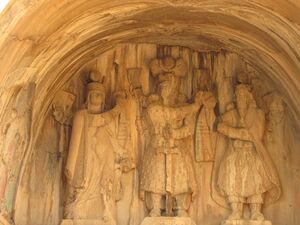
Khosrow restored the practice of erecting rock reliefs, after an absence of nearly three centuries, the last one being erected under Shapur III (ح. 383–388).[31] At Taq-e Bostan, Khosrow mimicked and magnified the rock relief of Shapur III.[31] His relief, known as the "Great Ayvan", is in a barrel vault carved in a cliff. The ayvan is split into an upper and lower section; the upper section depicts a divine investiture scene, with the Zoroastrian divinities Ahura Mazda and Anahita each giving Khosrow a diadem.[31] The lower section depicts Khosrow II on horseback, wearing full body armor, whilst holding a lance and shield. His head is encircled by a halo, which according to Howard-Johnston, is most likely a representation of his xwarrah, i.e. kingly glory.[5][31] On the left side panel, a boar hunt scene is depicted, portraying Khosrow on a boat whilst aiming a bow. On the right, there is a deer hunt scene. The relief, however, is unfinished, probably due to Khosrow's setback in the later stages of the war and his eventual downfall.[5]
Coinage

Khosrow, during his second reign, added the ideogram GDH, meaning xwarrah ("royal splendor") on his coins. He combined this together with the word abzōt ("he has increased"), making the full inscription thus read as: "Khosrow, he has increased the royal splendor" (Khūsrōkhwarrah abzōt).[32] The title of King of Kings–missing since the reign of Peroz I (ح. 459–484)–was also restored on his coins.[32] According to Shayegan, Khosrow's adoption of the title was "undoubtedly a consequence of his Byzantine policy," and was signifying a resurrection of the ancient Achaemenid Empire.[33] His two successors, Kavad II (ح. 628–628) and Ardashir III (ح. 628–630), refrained from using the title, seemingly in order distance themselves from him.[32]
In art
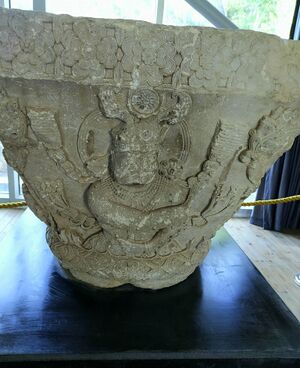
The battles between Heraclius and Khosrow are depicted in a famous early Renaissance fresco by Piero della Francesca, part of the History of the True Cross cycle in the church of San Francesco, Arezzo. Many Persian miniature paintings depict events in his life, like his battles or his assassination.
Family
Khosrow was the son of Hormizd IV, and an unnamed Ispahbudhan noblewoman who was the sister of Vistahm and Vinduyih. Khosrow also had two cousins from the Ispahbudhan family whom were named Mah-Adhur Gushnasp and Narsi.[34] He had a brother-in-law named Hormuzan,[35] a Sasanian nobleman from one of the seven Parthian clans, who later fought against the Arabs during the Muslim invasion of Persia. However, this is most likely wrong since Kavad's mother was a Byzantine princess named Maria.[36]
Khosrow married three times: first to Maria, a daughter of the Byzantine emperor Maurice, who bore him Kavad II. Then to Gordiya, the sister of Bahram Chobin, who bore him Javanshir. Then to Shirin, who bore him Mardanshah.[5] Khosrow also had other children whom were named: Borandukht, Azarmidokht, Shahriyar and Farrukhzad Khosrow V. All these persons except Shahriyar would later become the monarch of Iran during the Sasanian civil war of 628-632. Khosrow had a brother named Kavad and a sister named Mirhran, who was married to the Sasanian spahbed Shahrbaraz, and later bore him Shapur-i Shahrvaraz,[37] while Kavad married an unnamed woman who bore him Khosrow III.
Family tree
| Khosrow I (531–579) | Shapur († 580s) | ||||||||||||||||||||||||||||||||||||||||||||||||||||||||||||||||||||
| Hormizd IV (579–590) | Unknown | Vistahm (590/1–596 or 594/5–600) | Vinduyih | Unnamed noblewoman | Jushnas | ||||||||||||||||||||||||||||||||||||||||||||||||||||||||||||||||
| Khosrow II (590–628) | Kavad | Mirhran | Mah-Adhur Gushnasp | Narsi | |||||||||||||||||||||||||||||||||||||||||||||||||||||||||||||||||
| Kavad II (628) | Azarmidokht (630–631) | Mardanshah († 628) | Javanshir | Khosrow III (630) | Shapur-i Shahrvaraz (630) | Anoshagan | Bistam | ||||||||||||||||||||||||||||||||||||||||||||||||||||||||||||||
| Borandukht (629–630, 631–632) | Farrukhzad Khosrow V (631) | Shahriyar († 628) | Unknown | Kavad Gushnasp | Tamahij | ||||||||||||||||||||||||||||||||||||||||||||||||||||||||||||||||
مقتله
قًتِلَ كسرى الثاني في فبراير عام 628 م .
انظر أيضاً
- Babai the Great
- Behistun Inscription
- Behistun Palace
- Kisra legend, an African migration myth that historian Leo Frobenius argued was based on Khosrow II
- Muqawqis, Ruler of Alexandria
- Non-Muslim interactants with Muslims during Muhammad's era
- Shabdiz Khosrow's highly admired horse
- Ganj-e Badavard
المصادر
تاريخ الأمم والملوك للطبري
Further reading
- Hämeen-Anttila, Jaakko (2022). "The Letters of Shahrbarāz and Middle Persian Historiography on the Last Great War of Late Antiquity" (PDF). Journal of Late Antique, Islamic and Byzantine Studies. 1 (1–2): 65–93. doi:10.3366/jlaibs.2022.0005. S2CID 263274105.
- Piras, Andrea (2022). "Apocalyptic Imagery and Royal Propaganda in Khosrow II's Letter to the Byzantine Emperor Maurice". Journal of Persianate Studies. 14 (1–2): 178–195. doi:10.1163/18747167-bja10018. S2CID 251787417.
كسرى الثاني وُلِد: ح. 570 توفي: February 628
| ||
| سبقه Hormizd IV |
King of Kings of Iran and non-Iran 590 |
تبعه Bahram Chobin |
| سبقه Bahram Chobin |
King of Kings of Iran and non-Iran 591–628 |
تبعه Kavad II |
| قبله: بهرام السادس |
الحكام الساسانيون 590 - 628 |
بعده: قباذ الثاني |
خطأ استشهاد: وسوم <ref> موجودة لمجموعة اسمها "lower-alpha"، ولكن لم يتم العثور على وسم <references group="lower-alpha"/>
- ^ Skjærvø 2000.
- ^ أ ب Nicholson, Canepa & Daryaee 2018.
- ^ Rapp 2014.
- ^ Schmitt & Bailey 1986.
- ^ أ ب ت ث ج ح خ د ذ ر ز س ش Howard-Johnston 2010.
- ^ Shahbazi 2004, pp. 466–467.
- ^ Hansman 1986, pp. 277–278.
- ^ أ ب ت ث ج ح خ د ذ Shahbazi 1988, pp. 514–522.
- ^ أ ب Shayegan 2013, p. 810.
- ^ Pourshariati 2008, p. 96.
- ^ أ ب Shahbazi 1989, pp. 180–182.
- ^ Al-Tabari 1985–2007, v. 5: p. 49.
- ^ أ ب ت Rezakhani 2017, p. 178.
- ^ Kia 2016, p. 241.
- ^ Greatrex & Lieu 2002, p. 172.
- ^ أ ب Greatrex & Lieu 2002, p. 173.
- ^ Martindale, Jones & Morris 1992, p. 251.
- ^ Rawlinson 2004, p. 509.
- ^ Greatrex & Lieu 2002, p. 174.
- ^ Pourshariati 2008, pp. 128–129.
- ^ أ ب Pourshariati 2008, p. 129.
- ^ أ ب Kia 2016, p. 242.
- ^ Pourshariati 2008, pp. 133–134.
- ^ Payne 2015, p. 2.
- ^ أ ب Daryaee 2014, p. 56.
- ^ أ ب Frye 1983, p. 166.
- ^ Frye 1983, p. 171.
- ^ Payne 2015, p. 200.
- ^ أ ب ت Payne 2015, p. 168.
- ^ Frye 1983, p. 172.
- ^ أ ب ت ث Canepa 2018, p. 361.
- ^ أ ب ت Schindel 2013, p. 837.
- ^ Shayegan 2013, pp. 806, 812–813.
- ^ Pourshariati 2008, p. 179.
- ^ Shahbazi 2004b.
- ^ Pourshariati 2008, p. 236.
- ^ Pourshariati 2008, p. 205.
- Short description is different from Wikidata
- Articles containing Middle Persian-language text
- Articles with hatnote templates targeting a nonexistent page
- Khosrow II
- 570s births
- 628 deaths
- 6th-century Sasanian monarchs
- 7th-century Sasanian monarchs
- Leaders ousted by a coup
- One Thousand and One Nights characters
- People of the Byzantine–Sasanian War of 602–628
- Caucasian Albania
- Governors of the Sasanian Empire
- شخصيات الشاهنامه
- Executed monarchs
- ساسانيون
- وفيات 628
